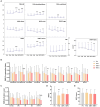Long-term effects of mobile exoneuromusculoskeleton (ENMS)-assisted self-help telerehabilitation after stroke
- PMID: 38545602
- PMCID: PMC10965606
- DOI: 10.3389/fnins.2024.1371319
Long-term effects of mobile exoneuromusculoskeleton (ENMS)-assisted self-help telerehabilitation after stroke
Abstract
Investigation on long-term effects of robot-assisted poststroke rehabilitation is challenging because of the difficulties in administration and follow-up of individuals throughout the process. A mobile hybrid neuromuscular electrical stimulation (NMES)-robot, i.e., exoneuromusculoskeleton (ENSM) was adopted for a single-group trial to investigate the long-term effects of the robot-assisted self-help telerehabilitation on upper limb motor function after stroke. Twenty-two patients with chronic stroke were recruited to attend a 20-session telerehabilitation program assisted by the wrist/hand module of the ENMS (WH-ENMS). Participants were evaluated before, after, as well as at 3 months and 6 months after the training. The primary outcome measure was the Fugl-Meyer Assessment-Upper Extremity (FMA-UE), supplemented by secondary outcome measures of the FMA-UE of the shoulder and elbow (FMA shoulder/elbow), the FMA-UE of the wrist and hand (FMA wrist/hand), the Modified Ashworth Scale (MAS), the Action Research Arm Test (ARAT), the Wolf Motor Function Test (WMFT), the Functional Independence Measure (FIM), as well as electromyography (EMG) and kinematic measurements. Twenty participants completed the telerehabilitation program, with 19 returning for a 3-month follow-up, and 18 for a 6-month follow-up. Significantly improved clinical scores were observed after the training (p ≤ 0.05). These improvements were maintained after 6 months in the FMA-UE, FMA shoulder/elbow, MAS at the wrist flexor, WMFT score, WMFT time, and FIM (p ≤ 0.05). The maintained improvements in motor function were attributed to reduced muscular compensation, as indicated by EMG and kinematic parameters. The WH-ENMS-assisted self-help telerehabilitation could achieve long-lasting rehabilitative effects in chronic stroke.
Keywords: long term; rehabilitation; robot; stroke; telerehabilitation; upper limb.
Copyright © 2024 Qing, Nam, Shum, Chan, Yu, Ng, Yang and Hu.
Conflict of interest statement
The authors declare that the research was conducted in the absence of any commercial or financial relationships that could be construed as a potential conflict of interest. The handling editor PZ declared a past co-authorship with the author XH.
Figures


References
-
- Ashworth B. (1964). Preliminary trial of carisoprodal in multiple sclerosis. Practitioner 192, 540–542. PMID: - PubMed
-
- Burgar C. G., Lum P. S., Scremin A. M., Garber S. L., Van der Loos H. F., Kenney D., et al. . (2011). Robot-assisted upper-limb therapy in acute rehabilitation setting following stroke: Department of Veterans Affairs multisite clinical trial. J. Rehabil. Res. Dev. 48, 445–458. doi: 10.1682/jrrd.2010.04.0062, PMID: - DOI - PubMed
-
- Chen S. Y., Winstein C. J. (2009). A systematic review of voluntary arm recovery in hemiparetic stroke: critical predictors for meaningful outcomes using the international classification of functioning, disability, and health. J. Neurol. Phys. Ther. 33, 2–13. doi: 10.1097/NPT.0b013e318198a010, PMID: - DOI - PubMed
LinkOut - more resources
Full Text Sources

